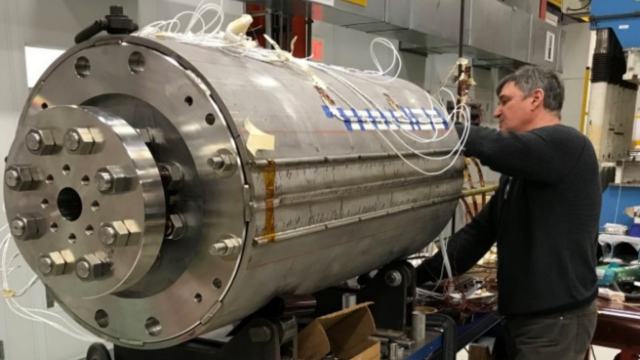Physicists at United States Department of Energy laboratory, Fermilab, have produced and tested a powerful magnet of the sort that could appear in the next generation of particle colliders.
Today’s largest particle accelerator is the Large Hadron Collider in Geneva, Switzerland, a ring of magnets 26.7 kilometers (16.6 miles) around. But plans exist for a Future Circular Collider, a 100-kilometre (100km) behemoth with 10 times the energy of the Large Hadron Collider. The bigger collider requires bigger magnets, of course.
[referenced url=”https://gizmodo.com.au/2019/06/large-hadron-collider-experiment-reveals-alien-structure-of-a-pentaquark/” thumb=”https://i.kinja-img.com/gawker-media/image/upload/t_ku-large/nk1gyx7jb1z7vtmtpojg.png” title=”Large Hadron Collider Experiment Reveals Alien Structure Of A ‘Pentaquark’” excerpt=”New results from the world’s largest particle accelerator illuminate the structure of the pentaquark, an exotic particle consisting of five quarks bound together.”]
“In the class of superconductor accelerator magnets, we are very close to the limit for this kind of technology,” Alexander Zlobin, a scientist at Fermilab, told Gizmodo. “But we are also thinking about how to break this limit using new ideas.”
Particle colliders produce and detect the smallest units of matter, like quarks and bosons, by accelerating protons or entire atomic nuclei to nearly the speed of light and smashing them together. Through the famous E=mc2 equation, new particles can appear from the energy of the collision, measurable with high-tech detectors that surround the collision point. Probing for higher-mass particles requires both larger accelerators and magnets with stronger fields—magnets like the one Fermilab has just debuted.
Superconducting magnets are based on a basic principle of physics. A coil with an electric current running through it generates a corresponding magnetic field running down the coil’s centre. Superconductors are materials that currents can travel through without resistance, and can thus produce more densely packed currents and create stronger magnets.
The Large Hadron Collider’s superconducting magnets generate fields of 8.3 Tesla, around the strength of a high-energy MRI machine. Eventually, scientists hope to produce an accelerator magnet with 16 Tesla for the Future Circular Collider. At 14.1 Tesla, Fermilab’s new test magnet is an important milestone and the strongest collider magnet yet. It was run at its operating temperature of 4.5 degrees above absolute zero (higher than the LHC’s operating temperature of 1.9 degrees above absolute zero). It is designed to run at 15 Tesla.
“The demonstration of a 14 T field in a dipole accelerator magnet and the possibility of reaching the target critical current density in R&D wires are milestones in the history of Nb3Sn conductor and a reassuring achievement for the [Future Circular Collider] magnet development program,” Amalia Ballarino, leader of the conductor activity at CERN, told the CERN Courier.
The key to making a stronger magnet was replacing the superconducting material from niobium titanium to niobium-3 tin. Not only can it be pushed to higher magnetic field strengths, but it can withstand those strengths without losing its superconducting abilities.
The Future Circular Collider is proposal to build an enormous, high-energy collider to replace the Large Hadron Collider. Scientists hope that moving to larger energies will uncover physical phenomena or new particles not yet seen at the LHC.
Development of new collider technology leads to benefits beyond just physics, which will hopefully be the case with the Future Circular Collider as well, according Michael Benedikt, a CERN physicist who led the concept studies for the collider. Stronger magnets can also be used for increasing the resolution in magnet-based medical imaging, for example.
The team is not at their 16 Tesla goal yet, but Benedikt says that Fermilab’s 14.1-Tesla magnet shows that scientists are on a path to eventually get there.
[referenced url=”https://gizmodo.com.au/2018/12/why-the-large-hadron-collider-is-shutting-down-for-two-years/” thumb=”https://i.kinja-img.com/gawker-media/image/upload/t_ku-large/hzfynmhtkla19zzayont.jpg” title=”Why The Large Hadron Collider Is Shutting Down For Two Years” excerpt=”The Large Hadron Collider, the world’s largest atom smasher, will be turned off for the next two years for upgrades. Hopefully, its particle-hunting abilities will be even better once it restarts in 2021.”]
